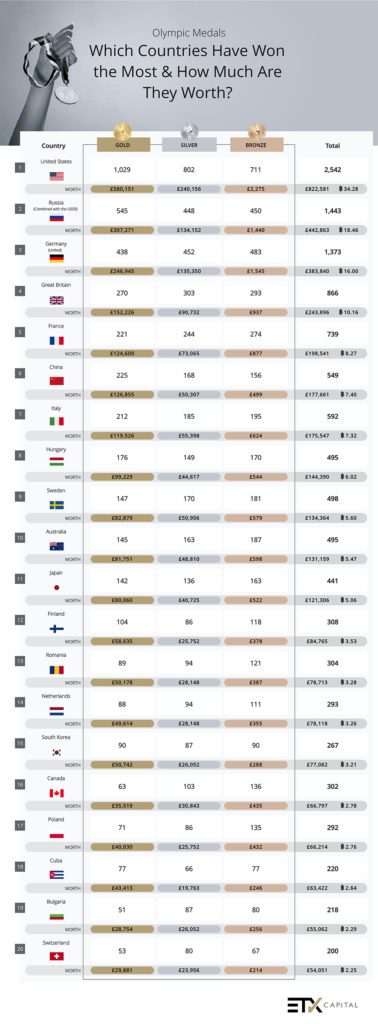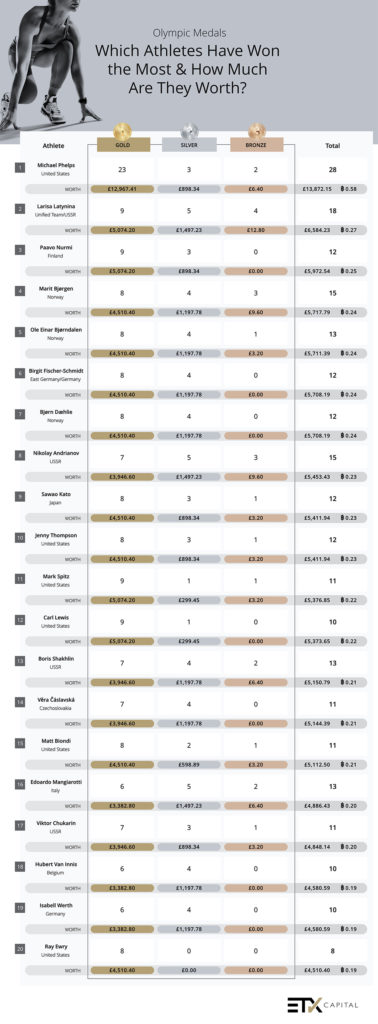Based on the firm’s estimations, Russia would take the second spot while Germany would take the third, netting £442,863 and £383,840 respectively.
“The Tokyo Olympics will be particularly interesting in the case of Russia – in 2019 the country was banned from all major sporting events for four years, meaning there’s a chance that the upcoming games could result in Russia losing second place in this ranking if Germany performs well,” ETX’s study reads.
Moving on, Great Britain would take fourth place. While its total medals are priced at less than 30% of the US’, that still leaves the country with nearly a quarter of a million pounds in metal value. Meanwhile, the rest of the top ten are primarily made of European countries, with the exceptions of China (6th) and Australia (10th).

Looking in detail at the athletes that have received the highest value in terms of medals, the British broker found that Michael Phelps would take first place – with a total of 23 gold medals along with three silvers and two bronzes.
Seven other American athletes also made it into the top 25 besides Phelps but, interestingly, only one of them – swimming champion Jenny Thompson in 10th – made it into the top ten.
Meanwhile, the rest of the ranking contains two athletes from the USSR, artistic gymnast Larisa Latynina in second and gymnast Nikolai Andrianov in eighth, as well as three from Norway, namely, cross-country skier Marit Bjørgen in fourth, biathlete Ole Einar Bjørndalen in fifth and cross-country skier Bjørn Dæhlie in seventh.
The top twenty athletes are primarily European or from the United States – the only exception being legendary gymnast Sawao Kato from Japan who occupies ninth place.

The calculations
To reach these conclusions, the ETX team had to take into consideration that Olympic medals aren’t made of pure gold, silver and bronze, as gold medals are usually gilded with gold but mostly comprised of silver and sometimes mixed with other materials like copper. Meanwhile, silver medals are primarily made of silver but often combined with other materials, and bronze medals tend to be mainly made of copper.
Even though there was a time when gold medals were entirely comprised of the yellow metal, this lasted only until 1912. Nowadays, however, the International Olympic Committee requires the gold medal to contain at least six grams of gold and silver of roughly 92.5% purity.
In addition to the shifts in regulations, the research team had to ponder the fact that each Olympic event has generated its own unique medals, both in terms of size and composition. For example, the Olympic medals at Rio weighed 500g and even though the silver medals were made of 100% of silver, the gold medals contained 1.2% gold and 98.8% silver for a total value of $564, while the bronze medals were made of 95% copper and 5% zinc.
London’s 2012 Olympic medals, on the other hand, had slightly different compositions, despite weighing the same – for instance, the gold medal had slightly more gold at around 1.34% but also contained 6.16% copper, bringing its amount of silver down to 92.5%.
Looking back at the 1904 games in Saint Louis and the 1908 games in London, the researchers found that the medals weighed about 72g but these were the only two events that offered solid gold medals which, at 2021 prices, would be worth well over $4,000.
“Because of these considerations, along with the fact that there isn’t a reliable, exhaustive dataset containing the materials of every Olympics’ medals and their composition, we felt it was necessary to standardize the rankings and calculate all medal values based on the materials that were used to create the 2016 Rio Olympic medals (this being the most recent),” the study reads. “Out of curiosity, we also converted these results to Bitcoin in order to see how much cryptocurrency each nation could theoretically buy with their medal earnings.”




